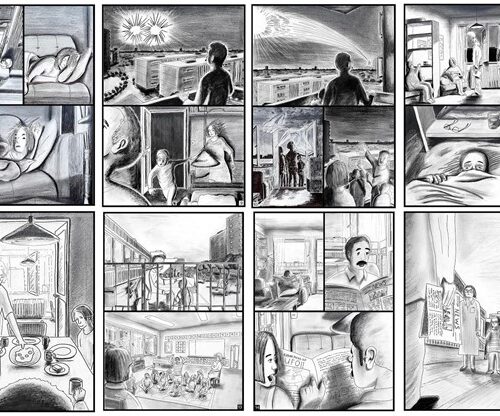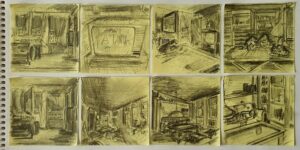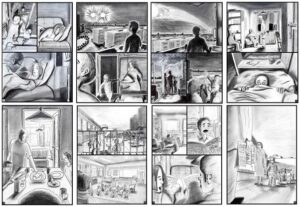
A conversation between Foundations Drawing student David Csaba and tutor Cheryl Huntbach
It may be interesting for prospective students, and others to know a little about your background, your life, and art experience prior to your OCA studies- for example from where you originate (how this may or may not inform your own studies / drawing work / process.
My name is Csaba David and I have recently finished my final project for my Foundation Drawing course; a course which I enrolled in as a way to sample online university learning, before taking on studies at degree level.
I am from Hungary but I’ve lived in Kuwait for most of my life, where I’ve built a career in education as an ESL (English as a Second Language) teacher. Although a career in education has always been stable as well as incredibly rewarding, it is not my passion but rather something that I stumbled into by chance.
Growing up I’ve always had an affinity and love for art, particularly drawing. It was the activity in my childhood that I vividly remember my brother and I doing all the time. As my drawings got better I remember copying and tracing images from whatever comic strips I had laying around, though strangely this never evolved into a love of comics or drawing my own comics.
Several years after graduating from high school I applied to study graphic design, but due to my living in Kuwait I was regarded as an overseas student, which made it financially unattainable. Little did I know that OCA already existed, but unfortunately I never came across it.
I attempted several times to enrol and study graphic design at university, for several reasons these were interrupted and fell short of my expectations, and so I put my dream on hold.
How did you hear of OCA, what made you choose or become interested in the Foundation, and other courses?
It puzzles me how I had not managed to come across OCA or UCA in previous searches, but what matters is that after many years of fruitless attempts at finding ways to pursue my dreams of studying what I am passionate about, with OCA I have finally found a perfect fit.
Originally I had plans to study Graphic Design but along my unconventional path to finding my way to OCA, my interests have changed or broadened slightly. As a consequence of my day time occupation, my frequent exposure to children’s literature has led me to develop a growing interest in illustration.
Since I was divided between Graphic design and Illustration, it dawned on me that I also had no experience in online learning at HE level, I felt it would be a good idea to get acquainted with the experience by taking one of the foundation courses. This would give me sufficient time to make a final decision about the degree I want to pursue. Out of all the foundation courses, I felt that drawing would best suit my needs in preparation for my future studies.
What did you hope / expect to experience and learn on the course? What didn’t you expect to learn / experience yet did?
My main hope for the foundation course was to learn the ins and outs of the program and get a taste of the expectations; to get a real feel for how I would cope with the workload and organize different aspects of studying online while holding down a full-time, and a part-time job.
Good time management has never been a strong point of mine, so that was definitely one element which I wanted to put to the test, especially if one is prone to procrastination like I am. I was somewhat apprehensive but thankfully, my tutor set realistic timeframes for assignments based on discussions prior to, and at different stages of the course. This helped me to finish the course within my personally set timeframe.
In what ways did you benefit from doing the Foundation course?
With regard to content and material, I think Foundation Drawing is a perfect stepping stone for future studies at an HE level, as well as a fantastic standalone course for anyone who wants to get acquainted with the skill of drawing at an informed and academic level.
It caters to students of all abilities and experience—as it begins the course with the basics and progressively introduces students to different elements of drawing. It also enables independently initiated, supplementary projects to help gain a more comprehensive and personal understanding of drawing processes, which ultimately help in preparation for final assignments.
An undeniably vital, and in my opinion the most beneficial element of the course was the feedback reports at every assignment, which evaluated my work and my progress in great detail and provided suggestions in all areas of my studies. These led me to be more inquisitive and provided a plethora of sources to inform my learning. They encouraged me to be more experimental while recognizing and reinforcing existing, well-established elements of my work. As a whole these formative reports promoted growth and independence.
Which aspects of the course did you enjoy or appreciate the most? and why? Which aspects did you find difficult, tough or didn’t interest you, and why?
When I started the course, I convinced myself to begin with an open mind and to approach every aspect of it with a positive attitude. This was something that I had signed up and paid to do, something that I wanted, and as such I tried to put myself in a mind frame where I would limit the room for mediocre effort in any and all areas of my studies. This sounds great and easy enough in theory but a lot harder to apply in practice—harder, but not impossible.
Like it or not, I inevitably had to face the reality that there were going to be parts of the course that I wouldn’t enjoy as much as others. One particular (and honestly the only) example of this is the reflection and research required to accompany the practical exercises.
I especially found it hard to critique, analyze and evaluate mine and other people’s work, and doing visual analysis is a very complex skill. However, I found myself getting gradually more comfortable and confident at coping with the task, to the point where now I actually miss the challenge when I’m not involved in writing about something. I still very much dislike doing it, but I’ve grown to LOVE to dislike it—if that makes any sense. I try to approach it as a challenge, which I know I eventually will tackle.
In contrast, amongst the many aspects of the course that I liked from the get go, one was the encouragement and the opportunity given by my tutor to expand and explore beyond the confines of the coursework. This led me to be more independent and initiate extra projects where I could apply and further experiment skills and techniques. These projects would end up taking center focus –at no expense of the assignments—and in a sense represented the culmination of all the knowledge learnt to that point.

Tell us something about the inspiration and development of your graphic narrative: What is the background or impulse behind the initial idea?
My final project for the Foundation Drawing course was a graphic short story inspired by the events of an unusual experience I had in my childhood.
What started out as a few messy sketches and doodles on Post-it notes, ended up being the catalyst for an elaborate project. This process allowed me to indicate my interest in illustration for future studies as well as providing an opportunity to experiment with various stages of producing a visual narrative.
After these initial sketches and a couple of larger detailed Conte crayon, and pen drawings, I presented the idea to my tutor as part of an earlier assignment. Once I got an approval and a number of suggestions on how to approach the project, I started taking deliberate steps towards its development.
I expanded my original drawings to a complete story and laid out the sequence of events on a draft storyboard.
I recall that during this particular project your working process changed dramatically and you began to ask lots of questions about your methods by juxtaposing the hand-drawn, and multi-layered digital manipulation. You also became more critical about what you were wanting to explore, develop and convey in the graphic narrative.
After researching a selection of graphic novels and illustrators, I experimented with different techniques, layouts and media til I found the right combination for my narrative. I wanted to achieve a dramatized documentary-like atmosphere, in which the drawings would have to rely heavily on the nuances of light and dark to convey the specific night-time setting and events.
After some trials and experimentation, I decided to use a monochrome scheme in soft pencils, a variety of black fine liners and markers to achieve the desired effect.
Once I was done with the colouring stage, I scanned in the final images and imported them into Photoshop. After various adjustments, I arranged the images in the desired page layout and applying some finishing touches to create the final narrative.
Having completed the graphic narrative over the past few months, what are your thoughts about how you did this?
During the production of this project, it did cross my mind that I may have bitten off a bit more than I could chew. In addition, pandemic related complications in my personal life also factored in and I had to ask for extensions for my final assignment. However, every moment of the extension I spent working towards finishing the project, not on procrastination or wondering about all the craziness around the world. In fact, I think it was my “little” project that kept me sane throughout these past few months.
It was a rather ambitious undertaking for me, and I enjoyed every minute and aspect of working on my own graphic short story. I am incredibly pleased with the final product and working on it only strengthened my determination to continue along this path in the future.

Did you know where you might be heading next? What advice or support did you receive to help you think about and plan your next step?
I took the foundation drawing course to re-introduce myself to academic learning and online HE study before committing to a degree. I was divided about which degree program I wanted to take and hoped the Foundation course would offer enough time to make my decision.
Having discussions with my tutor and consulting the literature available on the OCA website certainly did. I informed my tutor of my future intentions at the beginning of the course and therefore most of the communication was conducted with that information taken into consideration.
I realized that making a decision between graphic design and illustration wasn’t necessary as the Visual Communication Degree offers a combination of the two disciplines—exactly what I had in mind.
What advice might you give to someone thinking of studying a Foundation course?
I’m really glad that I have chosen to take this course. It provided everything I had hoped it would and more. The support I received was second to none and everyone I have been in contact with at OCA was nothing but approachable, understanding, professional, and incredibly helpful.
I think the number one advice I would give to someone is to just go for it. Once enrolled, get familiar with Getting started at OCA, Keeping an online learning blog, etc. to understand all the necessary information required for the course. Doing so helped me to get a good solid start.
Make a personal study plan / timetable and stick with it; the workload gets increasingly heavier especially with supplementary projects, and requires good organization to allocate time for practical, research and written work.
Heed the advice of the tutor and follow up on suggestions and provided sources. They are helpful, provide plenty of inspiration and lead one to experiment beyond the coursework, which results in more profound learning and ultimately a more rewarding experience.
And finally, something I haven’t done myself yet and need to make a greater effort at doing once I start my new course: Get in touch with other students enrolled in the same course (or others) to exchange ideas and obviously build a social network—which is vital these days.
Taking this course has completely taken over my life, in a positive sense. I realized the other day that every open tab on my phone/computer, each bookmark, photograph, or books are in one way or another connected to graphic design, or illustration. That put a smile on my face.
As a long term perspective, I have hopes to author and illustrate children’s books as well as getting started in an illustration/graphic design oriented career.
|
|







What a great insight into David’s progress on the Foundation. Very inspiring to see how skills and creativity grow. A future graphic novelist …